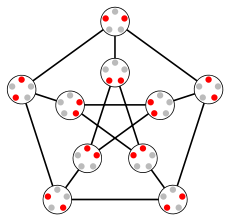|
Kneser graph
In graph theory, the Kneser graph K(n, k) (alternatively KGn,k) is the graph whose vertices correspond to the k-element subsets of a set of n elements, and where two vertices are adjacent if and only if the two corresponding sets are disjoint. Kneser graphs are named after Martin Kneser, who first investigated them in 1956. Examples The Kneser graph K(n, 1) is the complete graph on n vertices. The Kneser graph K(n, 2) is the complement of the line graph of the complete graph on n vertices. The Kneser graph K(2n − 1, n − 1) is the odd graph On; in particular O3 = K(5, 2) is the Petersen graph (see top right figure). The Kneser graph O4 = K(7, 3), visualized on the right. PropertiesBasic propertiesThe Kneser graph has vertices. Each vertex has exactly neighbors. The Kneser graph is vertex transitive and arc transitive. When , the Kneser graph is a strongly regular graph, with parameters . However, it is not strongly regular when , as different pairs of nonadjacent vertices have different numbers of common neighbors depending on the size of the intersection of the corresponding pairs of sets. Because Kneser graphs are regular and edge-transitive, their vertex connectivity equals their degree, except for which is disconnected. More precisely, the connectivity of is the same as the number of neighbors per vertex.[1] Chromatic numberAs Kneser (1956) conjectured, the chromatic number of the Kneser graph for is exactly n − 2k + 2; for instance, the Petersen graph requires three colors in any proper coloring. This conjecture was proved in several ways.
In contrast, the fractional chromatic number of these graphs is .[6] When , has no edges and its chromatic number is 1. Hamiltonian cyclesIt is well-known that the Petersen graph is not Hamiltonian, but it was long conjectured that this was the sole exception and that every other connected Kneser graph K(n, k) is Hamiltonian. In 2003, Chen showed that the Kneser graph K(n, k) contains a Hamiltonian cycle if[7] Since holds for all , this condition is satisfied if Around the same time, Shields showed (computationally) that, except the Petersen graph, all connected Kneser graphs K(n, k) with n ≤ 27 are Hamiltonian.[8] In 2021, Mütze, Nummenpalo, and Walczak proved that the Kneser graph K(n, k) contains a Hamiltonian cycle if there exists a non-negative integer such that .[9] In particular, the odd graph On has a Hamiltonian cycle if n ≥ 4. Finally, in 2023, Merino, Mütze and Namrata completed the proof of the conjecture.[10] CliquesWhen n < 3k, the Kneser graph K(n, k) contains no triangles. More generally, when n < ck it does not contain cliques of size c, whereas it does contain such cliques when n ≥ ck. Moreover, although the Kneser graph always contains cycles of length four whenever n ≥ 2k + 2, for values of n close to 2k the shortest odd cycle may have variable length.[11] DiameterThe diameter of a connected Kneser graph K(n, k) is[12] SpectrumThe spectrum of the Kneser graph K(n, k) consists of k + 1 distinct eigenvalues: Moreover occurs with multiplicity for and has multiplicity 1.[13] Independence numberThe Erdős–Ko–Rado theorem states that the independence number of the Kneser graph K(n, k) for is Related graphsThe Johnson graph J(n, k) is the graph whose vertices are the k-element subsets of an n-element set, two vertices being adjacent when they meet in a (k − 1)-element set. The Johnson graph J(n, 2) is the complement of the Kneser graph K(n, 2). Johnson graphs are closely related to the Johnson scheme, both of which are named after Selmer M. Johnson. The generalized Kneser graph K(n, k, s) has the same vertex set as the Kneser graph K(n, k), but connects two vertices whenever they correspond to sets that intersect in s or fewer items.[11] Thus K(n, k, 0) = K(n, k). The bipartite Kneser graph H(n, k) has as vertices the sets of k and n − k items drawn from a collection of n elements. Two vertices are connected by an edge whenever one set is a subset of the other. Like the Kneser graph it is vertex transitive with degree The bipartite Kneser graph can be formed as a bipartite double cover of K(n, k) in which one makes two copies of each vertex and replaces each edge by a pair of edges connecting corresponding pairs of vertices.[14] The bipartite Kneser graph H(5, 2) is the Desargues graph and the bipartite Kneser graph H(n, 1) is a crown graph. ReferencesNotes
Works cited
External links |
||||||||||||||||||




























